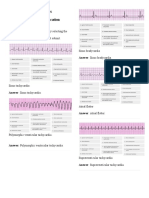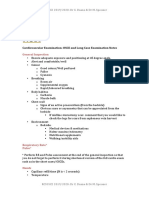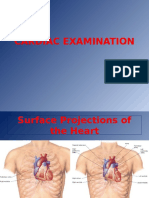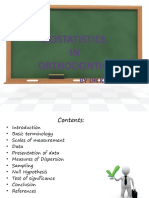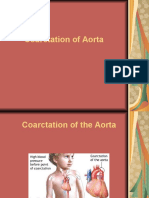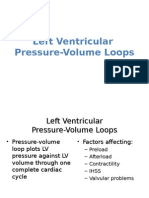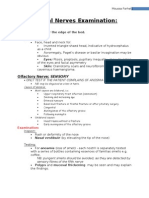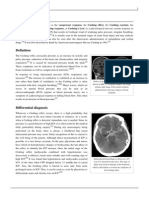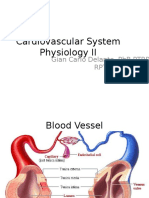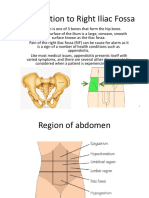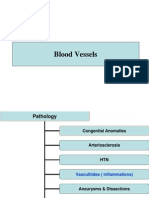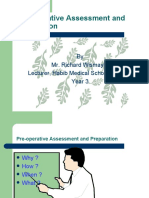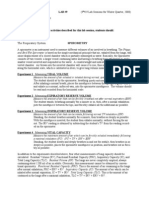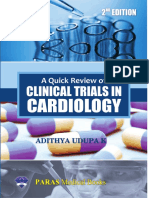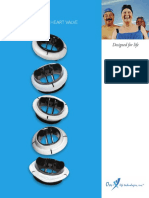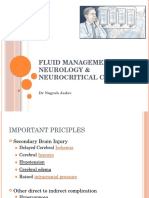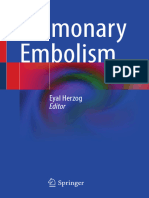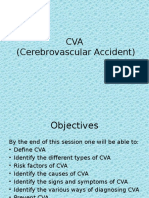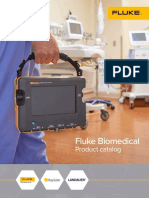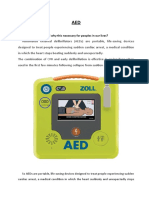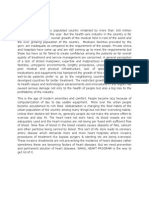Aortic Valve Stenosis by JAMA Cardiology
Aortic Valve Stenosis by JAMA Cardiology
Uploaded by
Zebedeus AndreasCopyright:
Available Formats
Aortic Valve Stenosis by JAMA Cardiology
Aortic Valve Stenosis by JAMA Cardiology
Uploaded by
Zebedeus AndreasCopyright
Available Formats
Share this document
Did you find this document useful?
Is this content inappropriate?
Copyright:
Available Formats
Aortic Valve Stenosis by JAMA Cardiology
Aortic Valve Stenosis by JAMA Cardiology
Uploaded by
Zebedeus AndreasCopyright:
Available Formats
JAMA CARDIOLOGY PATIENT PAGE
Aortic Valve Stenosis
Aortic stenosis is a narrowing of the aortic valve, the outflow valve of the heart between the left
ventricle (main pumping chamber) and the aorta (major blood vessel carrying blood to the body).
Theaorticvalvenormallyfunctionsasa1-wayvalvethatpreventsblood
Aortic Valve Stenosis
from leaking back into the heart. When the aortic valve narrows, the
heart has to work harder to pump blood into the aorta. Aortic steno- Blood flow through the aortic valve Healthy aortic valve (top view)
sis is caused by stiffening of the 3 valve leaflets, restricting its ability to
TO BODY
open normally. Aortic stenosis typically develops in individuals older Aorta
than 65 years but can also develop in younger individuals who are born
Healthy aortic
with an abnormal valve or develop rheumatic heart disease. valve
Open Closed
Left
What Are the Symptoms? ventricle
Symptoms of aortic stenosis include chest pressure, lightheaded- Aortic valve stenosis (top view)
ness or fainting, breathlessness, and/or fatigue. They indicate that
the extra work required to open the valve has overcome the heart’s
ability to work normally. Aortic stenosis is a slowly progressive dis-
ease. Many patients never develop symptoms and thus never need
to have the valve replaced. However, when symptoms develop or Open Closed
the obstruction becomes very severe, expeditious diagnosis and
treatment are critical.
cedure, has emerged as a preferable option for patients in whom
How Is It Diagnosed? open heart surgery poses risks. In TAVR, the new valve is inserted
Aortic stenosis is often first diagnosed when a physician hears a heart using a catheter without the need for open heart surgery. Rather than
murmur, caused by blood flowing rapidly through the valve (similar replacing the valve, as is done with surgery, the TAVR procedure in-
to a tight nozzle on a hose). More reliable diagnosis is made using serts a new valve inside the old aortic valve, pushing open the nar-
echocardiography to image the heart’s structure and function and to rowed leaflets and relieving the obstruction to flow.
measure the speed of blood traveling through the valve. Other tests If you have been diagnosed as having aortic stenosis, you should
includecardiaccatheterization,aprocedureinwhichsmalltubes(cath- consult with a cardiologist, who can advise you of your options.
eters) are inserted into blood vessels and passed directly across the Fortunately, there are more options for patients with this disease than
valve to determine its tightness, and imaging tests such as com- ever before.
puted tomography (CT) or magnetic resonance imaging (MRI).
How Is It Treated? FOR MORE INFORMATION
Medications are usually not effective in treating aortic stenosis as • Heart Valve Center, Columbia University Medical Center
this is a mechanical problem, and valve replacement is the only http://columbiaheartvalve.org/aortic-valve-treatment
proven therapy to improve symptoms and prolong life. Open heart • American Heart Association
surgery to replace the aortic valve has been an effective and du- http://ja.ma/heartorg
rable treatment for aortic stenosis for decades. In this operation, a • Medline Plus
heart surgeon removes the narrowed valve and replaces it with either https://www.nlm.nih.gov/medlineplus/ency/article/000178.htm
a tissue valve (from a cow, pig, or human) or a mechanical valve.
Transcatheter aortic valve replacement (TAVR), a less invasive pro-
Authors: Amisha Patel, MD, MS; Ajay J. Kirtane, MD, SM The JAMA Cardiology Patient Page is a public service of JAMA Cardiology. The
Published Online: July 13, 2016. doi:10.1001/jamacardio.2016.2060. information and recommendations appearing on this page are appropriate in most
instances, but they are not a substitute for medical diagnosis. For specific information
Conflict of Interest Disclosures: All authors have completed and submitted the concerning your personal medical condition, JAMA Cardiology suggests that you
ICMJE Form for Disclosure of Potential Conflicts of Interest. Dr Kirtane reported consult your physician. This page may be photocopied noncommercially by physicians
receiving institutional research grants to Columbia University and the Cardiovascular and other health care professionals to share with patients. To purchase bulk reprints,
Research Foundation from Boston Scientific, Medtronic, Abbott Vascular, Abiomed, call (312) 464-0776.
St Jude Medical, Eli Lilly and Co, Edwards Lifesciences, Volcano/Philips, and
CathWorks. No other disclosures were reported.
Section Editor: Mintu Turakhia, MD, MAS.
jamacardiology.com (Reprinted) JAMA Cardiology August 2016 Volume 1, Number 5 623
Copyright 2016 American Medical Association. All rights reserved.
Downloaded from jamanetwork.com by guest on 12/04/2018
You might also like
- ACLS Pre Test AnswersDocument10 pagesACLS Pre Test AnswersAirene Sible100% (3)
- Inferior Vena Cava and Its TributariesDocument12 pagesInferior Vena Cava and Its TributariesRahaf MajadlyNo ratings yet
- Chapter 11 The Cardiovascular SystemDocument25 pagesChapter 11 The Cardiovascular SystemYeshia InocencioNo ratings yet
- Cardiology - CVS OSCE ChecklistDocument5 pagesCardiology - CVS OSCE ChecklistPraveenaNo ratings yet
- FLOWCHARTDocument1 pageFLOWCHARTPatrick FormosoNo ratings yet
- Copy1 TOPANAT EXAM MCQ Nee RevisedDocument125 pagesCopy1 TOPANAT EXAM MCQ Nee Revisedkapil pancholiNo ratings yet
- 09 Pediatrics PLE 2019 RatioDocument66 pages09 Pediatrics PLE 2019 RatioMei Bejerano - Roldan100% (1)
- Concept MapDocument9 pagesConcept Mapsinai1012No ratings yet
- Assessment of Cardiovascular SystemDocument12 pagesAssessment of Cardiovascular SystemMaryrose Suelto Soliano BautistaNo ratings yet
- Intervertebral Disc)Document28 pagesIntervertebral Disc)arlinieNo ratings yet
- Abdominal IncisionDocument4 pagesAbdominal IncisionMohit KumarNo ratings yet
- Azygos VeinDocument2 pagesAzygos VeinDr santoshNo ratings yet
- Cardiac ExaminationDocument23 pagesCardiac ExaminationAreza Eka PermanaNo ratings yet
- Primary Cardiac LymphomaDocument3 pagesPrimary Cardiac LymphomaHan KethyanethNo ratings yet
- 10 - Heart & Great Vessels (FF)Document72 pages10 - Heart & Great Vessels (FF)checkmateNo ratings yet
- Chest and Abdominal Injuries: Forensic Medicine by Yazan AbueidehDocument54 pagesChest and Abdominal Injuries: Forensic Medicine by Yazan AbueidehRayyan Alali100% (1)
- Bio StatisticsDocument122 pagesBio StatisticsSweta SaravananNo ratings yet
- Suprarenal (Adrenal) Gland: Dr. R. SanthakumarDocument33 pagesSuprarenal (Adrenal) Gland: Dr. R. SanthakumardrsubanNo ratings yet
- Coarctation of The AortaDocument15 pagesCoarctation of The AortaNadiyaSiddiquiNo ratings yet
- Vascular Diseases: Idar Mappangara Department of Cardiology Hasanuddin UniversityDocument31 pagesVascular Diseases: Idar Mappangara Department of Cardiology Hasanuddin UniversityHariadhii SalamNo ratings yet
- Approach To Cardiac MurmursDocument11 pagesApproach To Cardiac Murmurstouthang0074085No ratings yet
- LV Pressure Volume LoopsDocument21 pagesLV Pressure Volume LoopsMayuresh ChaudhariNo ratings yet
- Neurogenic BladderDocument11 pagesNeurogenic BladderRoy LiemNo ratings yet
- Back - ClinicalKeyDocument37 pagesBack - ClinicalKeyElianaNo ratings yet
- CRANIAL Nerves - ExaminationDocument14 pagesCRANIAL Nerves - ExaminationMoussa FarhatNo ratings yet
- 06 Bones of Lower LimbDocument42 pages06 Bones of Lower LimbbnvjNo ratings yet
- Peripheral Arterial DiseaseDocument5 pagesPeripheral Arterial Diseaseampogison080% (1)
- Cardiac Cycle - DR Rakesh JainDocument97 pagesCardiac Cycle - DR Rakesh JainEmmieNo ratings yet
- Laminar AirflowDocument15 pagesLaminar AirflowKamran AshrafNo ratings yet
- Body Fluids and ElectrolytesDocument30 pagesBody Fluids and ElectrolytesALLAINE MARIE TANNo ratings yet
- CSFDocument40 pagesCSFDrNaveen Singh Rajpurohit KaduNo ratings yet
- Cushing ReflexDocument6 pagesCushing ReflexSureshNo ratings yet
- How To Read Chest X-RayDocument65 pagesHow To Read Chest X-RayKatty MelnykovaNo ratings yet
- 05 Cardiovascular System Physiology Part2Document37 pages05 Cardiovascular System Physiology Part2Kaye Alyssa EnriquezNo ratings yet
- "Must Know" Classifications: Gustillo Salter-HarrisDocument4 pages"Must Know" Classifications: Gustillo Salter-HarrisHo Yong WaiNo ratings yet
- Antianginal DrugsDocument14 pagesAntianginal DrugsDRABHIJITNo ratings yet
- EmbolismDocument13 pagesEmbolismSandeep Bansal100% (1)
- Yl IRIDOCYCLITISDocument14 pagesYl IRIDOCYCLITISNafisa FariddputryNo ratings yet
- Varices Esophagus PDFDocument7 pagesVarices Esophagus PDFDimas ErlanggaNo ratings yet
- Seminar 4Document49 pagesSeminar 4Yamuna SubramaniamNo ratings yet
- Aorta AnatomyDocument41 pagesAorta AnatomySingey LhendupNo ratings yet
- Cardiovascular DiseaseDocument12 pagesCardiovascular DiseaseVipul NagnesiaNo ratings yet
- AsdaDocument42 pagesAsdaratchagarajaNo ratings yet
- VasculitidesDocument13 pagesVasculitidesIrene Zae MwandotoNo ratings yet
- Neurosurgery For NeurologistsDocument44 pagesNeurosurgery For NeurologistsDilip Kumar MNo ratings yet
- PPTDocument28 pagesPPTuculucull100% (1)
- Pleural TapingDocument6 pagesPleural TapingLiza KameliaNo ratings yet
- Hypoxia TypesDocument3 pagesHypoxia TypesyelloweverglowNo ratings yet
- Chapter 9 Cardiac MuscleDocument5 pagesChapter 9 Cardiac MuscleYheng GaosaiiNo ratings yet
- IMD - Step-Up To USMLE Step 3 - Chapter 1 - CardiologyDocument124 pagesIMD - Step-Up To USMLE Step 3 - Chapter 1 - CardiologyAly SherifNo ratings yet
- Aortic DissectionDocument67 pagesAortic DissectionPIYALI BISWAS100% (1)
- Cme - Fat Embolism SyndromeDocument14 pagesCme - Fat Embolism Syndromeadib azharNo ratings yet
- Preoperative Preparation of Patient For SurgeryDocument23 pagesPreoperative Preparation of Patient For SurgeryFauzi SebunyaNo ratings yet
- Endoscopic, Retrograde Cholangio Pancreatography ERCPDocument17 pagesEndoscopic, Retrograde Cholangio Pancreatography ERCPHamzeh AlmasriNo ratings yet
- Anatomy of EsophagusDocument18 pagesAnatomy of Esophagusgabbyneng0% (1)
- Aortic RegurgitationDocument134 pagesAortic RegurgitationAbnet WondimuNo ratings yet
- The Vital SignsDocument5 pagesThe Vital SignsKhalid EppingNo ratings yet
- SPIROMETRYDocument5 pagesSPIROMETRYJayarubini JeyapalNo ratings yet
- Acute MiDocument45 pagesAcute Migiri00767098100% (1)
- GASTRODocument94 pagesGASTROriskyy1100% (1)
- Congestive Heart FailureDocument14 pagesCongestive Heart FailureBella Trix PagdangananNo ratings yet
- Fibrous Skeleton of Heart PDFDocument2 pagesFibrous Skeleton of Heart PDFMeghan0% (1)
- Cardiac Output: Dr. AthulyaDocument29 pagesCardiac Output: Dr. AthulyaamrendraNo ratings yet
- Electrocardiogram: What Is An ECG?Document8 pagesElectrocardiogram: What Is An ECG?Ali dhyaa100% (1)
- Ischemic StrokeDocument77 pagesIschemic StrokePetrescu Camelia100% (3)
- Good BooksDocument16 pagesGood BooksFbihansip bancel100% (1)
- Concomitant Bentall Operation Plus Aortic Arch Replacement SurgeryDocument7 pagesConcomitant Bentall Operation Plus Aortic Arch Replacement Surgeryprofarmah6150No ratings yet
- College of Nursing: Pharmacology Drug StudyDocument2 pagesCollege of Nursing: Pharmacology Drug StudyChristine Pialan SalimbagatNo ratings yet
- 03 Cardiovascular SystemDocument53 pages03 Cardiovascular SystemMSKCNo ratings yet
- Sphygmomanometer RepairDocument5 pagesSphygmomanometer Repairver_at_workNo ratings yet
- On-X Prosthetic Heart Valve Catalog: Designed For LifeDocument4 pagesOn-X Prosthetic Heart Valve Catalog: Designed For LifeTuyen nguyen ngocNo ratings yet
- Electrocardiography for healthcare professionals Booth all chapter instant downloadDocument52 pagesElectrocardiography for healthcare professionals Booth all chapter instant downloadabalcobiobio100% (1)
- Fluid Management in Neurology & Neurocritical Care: DR Nagesh JadavDocument12 pagesFluid Management in Neurology & Neurocritical Care: DR Nagesh JadavNagesh JadavNo ratings yet
- Anesth Analg 1998 Puri 808 11Document4 pagesAnesth Analg 1998 Puri 808 11dendikarmenaNo ratings yet
- The Human Heart: Learner's Book Pg. # 8-9Document17 pagesThe Human Heart: Learner's Book Pg. # 8-9hareem FatimaNo ratings yet
- Blood Clot Symptoms To KnowDocument6 pagesBlood Clot Symptoms To KnowRaprnaNo ratings yet
- Eyal Herzog (Editor) - Pulmonary Embolism-Springer (2021)Document288 pagesEyal Herzog (Editor) - Pulmonary Embolism-Springer (2021)Frederico PóvoaNo ratings yet
- CvaDocument20 pagesCvanuraNo ratings yet
- Cardiopulmonary ResuscitationDocument42 pagesCardiopulmonary ResuscitationDe EnNo ratings yet
- Cerebrovascular DiseasesDocument16 pagesCerebrovascular DiseasesSopna ZenithNo ratings yet
- Heart Rate Variability: - Dattaraj - Sansgiri - 10-548 - Raghav. Narasimhan - 11-501 - JUI - AGAM - 11-502Document27 pagesHeart Rate Variability: - Dattaraj - Sansgiri - 10-548 - Raghav. Narasimhan - 11-501 - JUI - AGAM - 11-502cloantafNo ratings yet
- Catalogo Fluke Biomedical 2019Document37 pagesCatalogo Fluke Biomedical 2019Fabricio AlmeidaNo ratings yet
- Full Chapter An Insiders Guide To Clinical Medicine 1St Edition Archith Boloor Anudeep Padakanti PDFDocument53 pagesFull Chapter An Insiders Guide To Clinical Medicine 1St Edition Archith Boloor Anudeep Padakanti PDFmatthew.mullin215100% (8)
- Science 9Document29 pagesScience 9HanessyNo ratings yet
- Validation of The Finometer Device For MeasurementDocument7 pagesValidation of The Finometer Device For MeasurementLevente BalázsNo ratings yet
- AED DesignDocument17 pagesAED DesignAlina BarkovaNo ratings yet
- SAAOL Heart Centre CaseDocument9 pagesSAAOL Heart Centre CaseMunem ChowdhuryNo ratings yet
- 1700 MCQ Revised VersionDocument485 pages1700 MCQ Revised VersionLu YaNo ratings yet
- An Interesting Case of "Trigeminal Tachycardia"Document3 pagesAn Interesting Case of "Trigeminal Tachycardia"ABDULLAH ALHASANNo ratings yet
